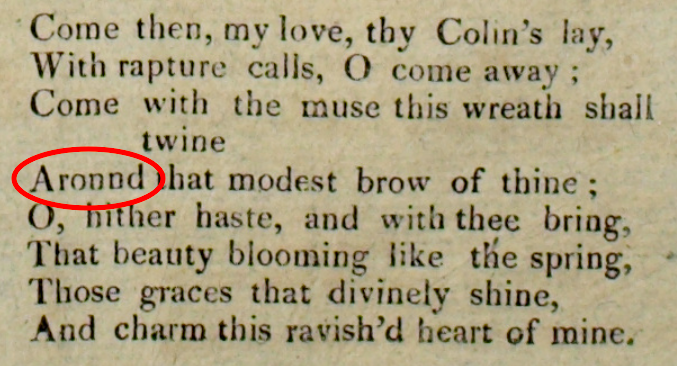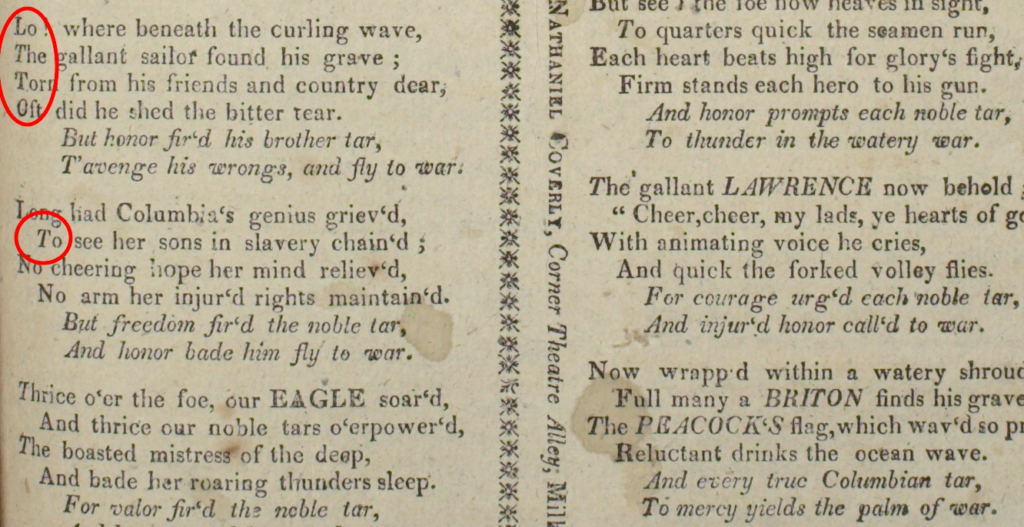
The Isaiah Thomas Broadside Ballads Project has been fully transcribed! Each of the more than three hundred ballads in the collection now has a text-searchable transcription, as well as the option to download an XML file of the document that includes tags related to the subject matter contained within the text (both can be found at the bottom of the page for each individual ballad).
Previous blog posts have detailed the unique place this project holds at the Society, the many features the website offers to help the reader navigate the holdings of the project, and how the Society collaborated with students of Assumption college to begin transcribing these documents to make them more accessible to all. An original member of this group of students, I fell in love with this project, and it has been my duty and pleasure to continue transcribing these ballads for AAS over the last year and a half. Having the chance to continue working so closely with the ballads has also made me think differently about the history of printing.
 When we consume written words today, we don’t think of the way in which they are being provided to us. They simply come over on a screen or through mass-produced books likely printed via automation. Connections we feel to the words most likely link us to the author and the author alone.
When we consume written words today, we don’t think of the way in which they are being provided to us. They simply come over on a screen or through mass-produced books likely printed via automation. Connections we feel to the words most likely link us to the author and the author alone.

Not so for the ballads. Sure, I read the content of each ballad as I was transcribing it, and I felt I could appreciate the emotions coming through the words themselves. More often, I found myself feeling more and more connected to Nathaniel Coverly, the printer of many of these documents. There are many aspects of the printing process that would be foreign to us. Think about actually having to lay out (backwards and upside down) every character you wanted someone to read. It seems almost miraculous that there are so few typos in the ballads to begin with, but it makes Coverly seem more human, more real, whenever you come across one. Some of my favorite typos to find when transcribing were when he would accidentally forget to invert an “n” or a “u,” creating words such as “turuing” instead of “turning.” I purposefully left these typos in the transcriptions both to more accurately reflect the physical printed words on the page, as well as to convey this same sentiment to the reader.
My other favorite “Easter egg” found in the ballads is also reflective of an aspect of the printing process that I believe would occur to very few of us. Typing with digital files, we have a limitless number of characters before us. We have no finite amount of the letter “A” or symbols such as a semicolon. Not true for printers such as Coverly. The ballads in the collection range from 200 to 1,000+ words, with most averaging somewhere around 500 to 600. Often, the lines in the ballad start with the same capital letter, often a “T” or an “I”. If you look closely enough, in many of the ballads you can see where Coverly ran out of capital “T”s (for example) and had to start using the italic versions of the characters simply to complete printing the ballad. I often liked to imagine Coverly mentally budgeting his use of different characters as he prepared the type for the ballad.

This is what makes this collection so unique. The ballads certainly give us the chance to catch a glimpse into the life of the “common person” in Boston during the early nineteenth century, getting to see and hear the songs that would have been playing in the streets, pubs, and homes of the city. They also give us the chance to peek into the life of a particular and important profession of the time and allow us to feel like we know one of those professionals just a little bit better. I found this to be both an interesting and rewarding part of working with these ballads, and I hope as you explore and enjoy them you find rewards of your own.

Thank you. I’m always interested to see other transcription policies: in setting policy for the TCP (including Evans) collections, we decided to correct inverted (and displaced) letters silently in the interests of better retrieval (which militated against capture as printed) and simplicity of tagging (which argued against capturing both ‘views’). I am curious though: you say you ‘puposely left [the inverted characters] in’: was that a personal decision affecting a few particular ballads? or a project-wide policy? … Substitute characters, as when a printer ran out of one letter or lacked the appropriate sort to begin with, are another problem, and we never did come up with a comprehensive policy for that. E.g “&” in place of the “ct” ligature and of course “J” in place of “I”